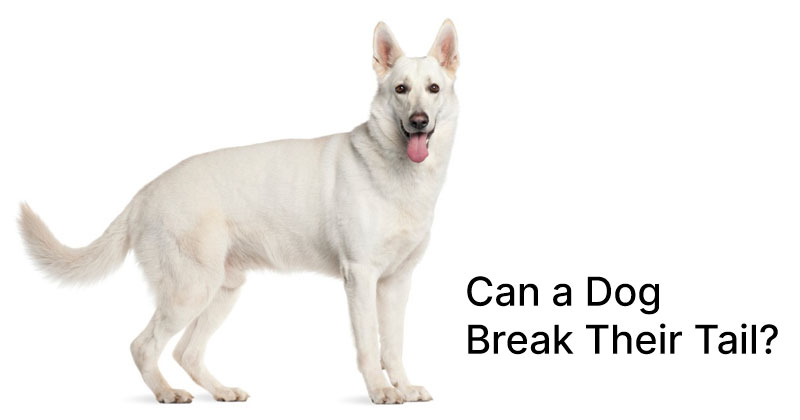
Dogs use their tails for communication, balance, and expression, but you might wonder if this seemingly sturdy body part can break. Whether from an accident, a rough play session, or another cause, dogs can indeed break their tails. Let’s take a closer look at tail injuries, their symptoms, and what you should do if you suspect your dog has broken their tail. If you're in Elkhorn, NE, and think your dog may have broken their tail, contact Skyline Veterinary Clinic at (402) 933-6800 or request an appointment.
Just like any other bone in the body, a dog’s tail can suffer from breaks or fractures. Since dogs often use their tails as a way of expressing excitement or happiness, a change in their usual tail movement might be the first indication that something is wrong. But what other signs should you look for?
A broken tail may cause noticeable physical changes in your dog. If your dog’s tail is broken, you might see
In severe cases, a dog may completely stop moving their tail, leading to what is sometimes called “limp tail” or “dead tail.” Pay close attention to these physical symptoms, especially if they occur suddenly after a fall, collision, or accident.
Dogs are often very expressive, and if your dog is suddenly behaving differently, it could be due to a tail injury. If a dog breaks their tail, they may become more reserved or show signs of discomfort. Common behavioral signs include:
Although a dog’s tail is quite flexible, it’s not immune to injuries. There are several common causes of tail injuries that can result in a break or fracture.
Dogs are active animals, and accidents are bound to happen. From getting their tail caught in a door, accidentally stepping on it, or injuring their tail during rough play, accidents are one of the most common causes of broken tails. Even a wagging tail can become injured if it repeatedly hits hard surfaces.
Falling from a height or colliding with furniture, walls, or even another dog can cause a break in the tail. Dogs with long, whip-like tails are particularly prone to injuries if they hit their tails against objects during moments of high energy or excitement.
Believe it or not, overuse can also lead to tail injuries. Dogs who swim a lot or dogs with high-energy wagging behaviors are at risk for what’s known as “limber tail syndrome,” which can sometimes result in fractures from strain. Overuse can weaken the muscles and bones in the tail, leading to injuries with even minor trauma.
If you think your dog has broken their tail, your first step should be to schedule a veterinary visit. While it may be tempting to assess the injury at home, professional care is essential for determining the severity of the break and offering appropriate treatment.
Your vet will perform a physical examination of your dog’s tail to determine if there is a break or if the injury is a soft tissue issue. They may recommend an X-ray to identify the exact location and severity of the break. In some cases, what appears to be a broken tail may actually be a severe strain, sprain, or dislocation, which is why diagnostics are so important.
Treatment will depend on the location and severity of the break. For minor fractures, rest and restricted movement may be enough to allow the tail to heal on its own. Your veterinarian may also prescribe pain relief to keep your dog comfortable during recovery. In more severe cases, where the break is complicated or the tail’s blood supply is compromised, surgery may be required. Amputation may also be necessary in rare cases where the tail is too damaged to heal properly or if it poses a risk of infection.
While it may not always be possible to prevent accidents, there are steps you can take to reduce the risk of future tail injuries. Here are a few ways to keep your dog’s tail safe:
Dogs with long tails or those that wag energetically can benefit from a home that’s “tail-proof.” Make sure to secure heavy objects that could fall if your dog’s tail bumps them and avoid leaving doors or gates where a dog’s tail could become trapped. When guests are over, remind them to be mindful of your dog’s tail, especially if your dog is excited and running around.
While you don’t want to stop your dog from having fun, supervising playtime and making sure your dog doesn’t overexert themselves can help prevent injuries. If your dog enjoys swimming, watch for signs of overuse, like a tired or limp tail, and give your dog breaks when needed.
A broken tail might seem like a minor injury, but without proper treatment, it can lead to long-term complications, including chronic pain, infection, or permanent disfigurement. The key to ensuring your dog’s health and comfort is to get veterinary care as soon as you notice signs of a tail injury.
For Elkhorn, NE residents, Skyline Veterinary Clinic is here to help with all your pet’s needs. Call (402) 933-6800 to schedule an appointment or request an evaluation. Don’t wait—taking action early can make all the difference for your dog’s recovery.


